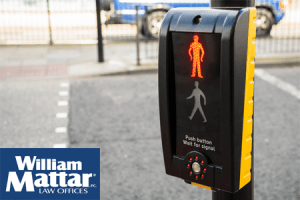March 12, 2021 | By William Mattar, P.C.
The Basics of Pedestrian Right of Way
 Often, when considering right of way, you hear, "pedestrians always have the right of way." There are many situations under which pedestrians have the right of way, including cases in which the pedestrian is already on the road, but that does not necessarily mean that pedestrians have the right of way in every situation.
Both pedestrians and the drivers of motor vehicles must exercise reasonable care and follow the rules of the road in order to ensure that everyone has the safest experience possible. Regardless of who has the right of way, motorists must always exercise reasonable care to avoid colliding with pedestrians.
Often, when considering right of way, you hear, "pedestrians always have the right of way." There are many situations under which pedestrians have the right of way, including cases in which the pedestrian is already on the road, but that does not necessarily mean that pedestrians have the right of way in every situation.
Both pedestrians and the drivers of motor vehicles must exercise reasonable care and follow the rules of the road in order to ensure that everyone has the safest experience possible. Regardless of who has the right of way, motorists must always exercise reasonable care to avoid colliding with pedestrians.
When Do Pedestrians Have Right of Way?
Articles 26 and 27 of the Vehicle and Traffic Law explains who has the right of way depending on the circumstances, including:
1. When a Pedestrian Enters a Crosswalk with a Traffic Control Signal
Traffic signals help govern who has the right of way and when pedestrians and drivers can safely move through an intersection or cross a street. When a pedestrian enters a crosswalk or intersection in the direction of a traffic signal, the pedestrian has the right of way, and drivers must obey the traffic control signal governing their lane of traffic.
Pedestrian right of way, under these circumstances, extends to both marked and unmarked crosswalks.
2. When a Motor Vehicle Has a Stop or Yield Sign
In all cases, motor vehicles must stop and yield to pedestrians when they have a stop or yield sign that governs their traffic pattern.
3. When a Clearly-Indicated Crosswalk Does Not Have a Traffic Signal
According to New York Law, pedestrians have right of way when they do not have a clearly-indicated traffic signal at a crosswalk.
4. When Pedestrians are on Sidewalks or Walkways
Sometimes, a motor vehicle may need to cross a walkway or sidewalk to enter a driveway or parking lot. However, when motorists must cross these areas, they must yield to pedestrians using those areas.
When Pedestrians Do Not Have Right of Way
While pedestrians may have right of way in many cases, there are some instances in which a pedestrian may not have right of way, including:
1. There is Not a Crosswalk on the Road
When crossing a road without a clear crosswalk, pedestrians must yield to motorists, rather than motorists yielding to pedestrians.
2. Motorists Have Right of Way Indicated by a Traffic Signal
Just as traffic signals control pedestrian movements, they also control motor vehicle movements. When a traffic signal indicates that the vehicle has right of way, the pedestrian must yield to the driver.
Motorists and Due Care
While motorists do not necessarily have to yield to pedestrians in all circumstances, they must exercise due care when sharing the road with pedestrians.
Drivers should exercise care and caution when sharing the road with pedestrians, regardless of who has right of way. That may include:
- Carefully looking out for pedestrians, regardless of who has right of way;
- Avoiding potential distractions while on the road, including loud music, eating and drinking, or looking at a phone or other device; and
- Looking out for pedestrians at all times.
In addition, drivers should follow all traffic control signals in the area, including observing stop signs, red lights, and yield signs. Failure to observe those signs can make it more difficult to predict driver behavior and can increase the risk of a serious pedestrian accident.
Hurt in a Pedestrian Accident? Call William Mattar
If a driver causes an accident with a pedestrian due to a motorist failing to yield the right of way, the pedestrian may deserve compensation for any injuries resulting from the accident.
If you have suffered injuries in a pedestrian accident, we can help. Contact William Mattar, PC, pedestrian accident lawyers, or call (844) 444 - 4444 for help with your pedestrian accident claim.
 Often, when considering right of way, you hear, "pedestrians always have the right of way." There are many situations under which pedestrians have the right of way, including cases in which the pedestrian is already on the road, but that does not necessarily mean that pedestrians have the right of way in every situation.
Both pedestrians and the drivers of motor vehicles must exercise reasonable care and follow the rules of the road in order to ensure that everyone has the safest experience possible. Regardless of who has the right of way, motorists must always exercise reasonable care to avoid colliding with pedestrians.
Often, when considering right of way, you hear, "pedestrians always have the right of way." There are many situations under which pedestrians have the right of way, including cases in which the pedestrian is already on the road, but that does not necessarily mean that pedestrians have the right of way in every situation.
Both pedestrians and the drivers of motor vehicles must exercise reasonable care and follow the rules of the road in order to ensure that everyone has the safest experience possible. Regardless of who has the right of way, motorists must always exercise reasonable care to avoid colliding with pedestrians.